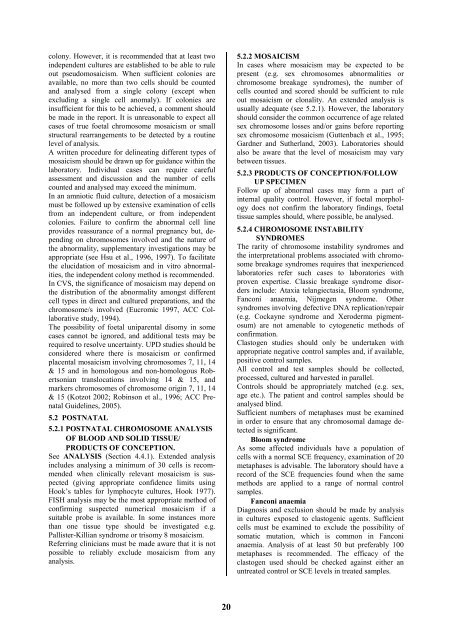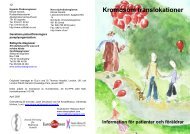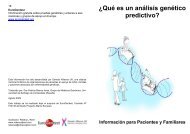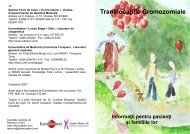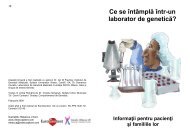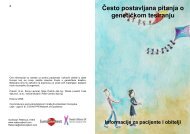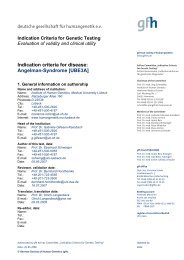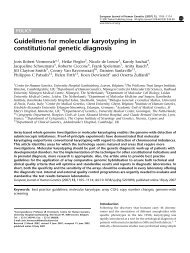Cytogenetic Guidelines and Quality Assurance - EuroGentest
Cytogenetic Guidelines and Quality Assurance - EuroGentest
Cytogenetic Guidelines and Quality Assurance - EuroGentest
Create successful ePaper yourself
Turn your PDF publications into a flip-book with our unique Google optimized e-Paper software.
colony. However, it is recommended that at least two<br />
independent cultures are established to be able to rule<br />
out pseudomosaicism. When sufficient colonies are<br />
available, no more than two cells should be counted<br />
<strong>and</strong> analysed from a single colony (except when<br />
excluding a single cell anomaly). If colonies are<br />
insufficient for this to be achieved, a comment should<br />
be made in the report. It is unreasonable to expect all<br />
cases of true foetal chromosome mosaicism or small<br />
structural rearrangements to be detected by a routine<br />
level of analysis.<br />
A written procedure for delineating different types of<br />
mosaicism should be drawn up for guidance within the<br />
laboratory. Individual cases can require careful<br />
assessment <strong>and</strong> discussion <strong>and</strong> the number of cells<br />
counted <strong>and</strong> analysed may exceed the minimum.<br />
In an amniotic fluid culture, detection of a mosaicism<br />
must be followed up by extensive examination of cells<br />
from an independent culture, or from independent<br />
colonies. Failure to confirm the abnormal cell line<br />
provides reassurance of a normal pregnancy but, depending<br />
on chromosomes involved <strong>and</strong> the nature of<br />
the abnormality, supplementary investigations may be<br />
appropriate (see Hsu et al., 1996, 1997). To facilitate<br />
the elucidation of mosaicism <strong>and</strong> in vitro abnormalities,<br />
the independent colony method is recommended.<br />
In CVS, the significance of mosaicism may depend on<br />
the distribution of the abnormality amongst different<br />
cell types in direct <strong>and</strong> cultured preparations, <strong>and</strong> the<br />
chromosome/s involved (Eucromic 1997, ACC Collaborative<br />
study, 1994).<br />
The possibility of foetal uniparental disomy in some<br />
cases cannot be ignored, <strong>and</strong> additional tests may be<br />
required to resolve uncertainty. UPD studies should be<br />
considered where there is mosaicism or confirmed<br />
placental mosaicism involving chromosomes 7, 11, 14<br />
& 15 <strong>and</strong> in homologous <strong>and</strong> non-homologous Robertsonian<br />
translocations involving 14 & 15, <strong>and</strong><br />
markers chromosomes of chromosome origin 7, 11, 14<br />
& 15 (Kotzot 2002; Robinson et al., 1996; ACC Prenatal<br />
<strong>Guidelines</strong>, 2005).<br />
5.2 POSTNATAL<br />
5.2.1 POSTNATAL CHROMOSOME ANALYSIS<br />
OF BLOOD AND SOLID TISSUE/<br />
PRODUCTS OF CONCEPTION.<br />
See ANALYSIS (Section 4.4.1). Extended analysis<br />
includes analysing a minimum of 30 cells is recommended<br />
when clinically relevant mosaicism is suspected<br />
(giving appropriate confidence limits using<br />
Hook’s tables for lymphocyte cultures, Hook 1977).<br />
FISH analysis may be the most appropriate method of<br />
confirming suspected numerical mosaicism if a<br />
suitable probe is available. In some instances more<br />
than one tissue type should be investigated e.g.<br />
Pallister-Killian syndrome or trisomy 8 mosaicism.<br />
Referring clinicians must be made aware that it is not<br />
possible to reliably exclude mosaicism from any<br />
analysis.<br />
20<br />
5.2.2 MOSAICISM<br />
In cases where mosaicism may be expected to be<br />
present (e.g. sex chromosomes abnormalities or<br />
chromosome breakage syndromes), the number of<br />
cells counted <strong>and</strong> scored should be sufficient to rule<br />
out mosaicism or clonality. An extended analysis is<br />
usually adequate (see 5.2.1). However, the laboratory<br />
should consider the common occurrence of age related<br />
sex chromosome losses <strong>and</strong>/or gains before reporting<br />
sex chromosome mosaicism (Guttenbach et al., 1995;<br />
Gardner <strong>and</strong> Sutherl<strong>and</strong>, 2003). Laboratories should<br />
also be aware that the level of mosaicism may vary<br />
between tissues.<br />
5.2.3 PRODUCTS OF CONCEPTION/FOLLOW<br />
UP SPECIMEN<br />
Follow up of abnormal cases may form a part of<br />
internal quality control. However, if foetal morphology<br />
does not confirm the laboratory findings, foetal<br />
tissue samples should, where possible, be analysed.<br />
5.2.4 CHROMOSOME INSTABILITY<br />
SYNDROMES<br />
The rarity of chromosome instability syndromes <strong>and</strong><br />
the interpretational problems associated with chromosome<br />
breakage syndromes requires that inexperienced<br />
laboratories refer such cases to laboratories with<br />
proven expertise. Classic breakage syndrome disorders<br />
include: Ataxia telangiectasia, Bloom syndrome,<br />
Fanconi anaemia, Nijmegen syndrome. Other<br />
syndromes involving defective DNA replication/repair<br />
(e.g. Cockayne syndrome <strong>and</strong> Xeroderma pigmentosum)<br />
are not amenable to cytogenetic methods of<br />
confirmation.<br />
Clastogen studies should only be undertaken with<br />
appropriate negative control samples <strong>and</strong>, if available,<br />
positive control samples.<br />
All control <strong>and</strong> test samples should be collected,<br />
processed, cultured <strong>and</strong> harvested in parallel.<br />
Controls should be appropriately matched (e.g. sex,<br />
age etc.). The patient <strong>and</strong> control samples should be<br />
analysed blind.<br />
Sufficient numbers of metaphases must be examined<br />
in order to ensure that any chromosomal damage detected<br />
is significant.<br />
Bloom syndrome<br />
As some affected individuals have a population of<br />
cells with a normal SCE frequency, examination of 20<br />
metaphases is advisable. The laboratory should have a<br />
record of the SCE frequencies found when the same<br />
methods are applied to a range of normal control<br />
samples.<br />
Fanconi anaemia<br />
Diagnosis <strong>and</strong> exclusion should be made by analysis<br />
in cultures exposed to clastogenic agents. Sufficient<br />
cells must be examined to exclude the possibility of<br />
somatic mutation, which is common in Fanconi<br />
anaemia. Analysis of at least 50 but preferably 100<br />
metaphases is recommended. The efficacy of the<br />
clastogen used should be checked against either an<br />
untreated control or SCE levels in treated samples.


